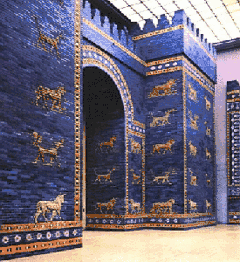
According to a theory proposed by Ignace Gelb, the Kish civilization encompassed the sites of Ebla and Mari in the Levant, Nagar in the north,[1] and the proto-Akkadian sites of Abu Salabikh and Kish in central Mesopotamia[2][3] in to the early East Semitic era in Mesopotamia and the Levant. The epoch began in the early 4th millennium BC and ended with the rise of the Akkadian empire.[4] The theory has been discarded by more recent scholarship.[5]
According to the theory, the East Semitic population migrated from what is now the Levant and spread into Mesopotamia,[6] and the new population could have contributed to the collapse of the Uruk period c. 3100 BC.[3] This early East Semitic culture was characterized by linguistic, literary and orthographic similarities extending from Ebla in the west to Abu Salabikh in the East.[7] The personal names from the Sumerian city of Kish showed an East Semitic nature and revealed that the city population had a strong Semitic component from the dawn of recorded history,[8] and since Gelb considered Kish to be the center of this civilization, hence the naming.[7]
The similarities included the using of a writing system that contained non-Sumerian logograms, the use of the same system in naming the months of the year, dating by regnal years and a similar measuring system.[7] However, each city had its own monarchical system.
While the languages of Mari and Ebla were closely related, Kish represented an independent East Semitic linguistic entity that spoke a dialect (Kishite),[9] different from both pre-Sargonic Akkadian and the Ebla-Mari language.[7]
See also
References
- ↑ Lauren Ristvet (2014). Ritual, Performance, and Politics in the Ancient Near East. Cambridge University Press. p. 217. ISBN 9781107065215.
- ↑ Van De Mieroop, Marc (2002). Erica Ehrenberg (ed.). In Search of Prestige: Foreign Contacts and the Rise of an Elite in Early Dynastic Babylonia. Eisenbrauns. p. 125-137 [133]. ISBN 9781575060552. Retrieved 23 February 2022.
{{cite book}}:|work=ignored (help) - 1 2 Wyatt, Lucy (2010). Approaching Chaos: Could an Ancient Archetype Save 21st Century Civilization?. O Books. p. 120. ISBN 9781846942556. Retrieved 23 February 2022.
- ↑ Hasselbach (2005). p. 4.
- ↑ Sommerfeld, Walter (2021). Vita, Juan-Pablo (ed.). The "Kish Civilization". Handbook of Oriental Studies. Section 1 The Near and Middle East. Vol. 1. BRILL. pp. 545–547. ISBN 9789004445215. Retrieved 23 February 2022.
{{cite book}}:|work=ignored (help) - ↑ Kitchen, A.; Ehret, C.; Assefa, S.; Mulligan, C.J. (2009). "Bayesian phylogenetic analysis of Semitic languages identifies an Early Bronze Age origin of Semitic in the Near East". Proc Biol Sci. 276 (1668): 2703–10. doi:10.1098/rspb.2009.0408. PMC 2839953. PMID 19403539.
- 1 2 3 4 Hasselbach, Rebecca (2005). Sargonic Akkadian: A Historical and Comparative Study of the Syllabic Texts. Otto Harrassowitz Verlag. p. 3. ISBN 9783447051729.
- ↑ Edwards, I. E. S.; Gadd, C. J.; Hammond, N. G. L. (1971). The Cambridge Ancient History. Cambridge University Press. p. 100. ISBN 9780521077910.
- ↑ Foster, Benjamin Read; Polinger Foster, Karen (2009). Civilizations of Ancient Iraq. Princeton University Press. p. 40. ISBN 978-0691137223.
